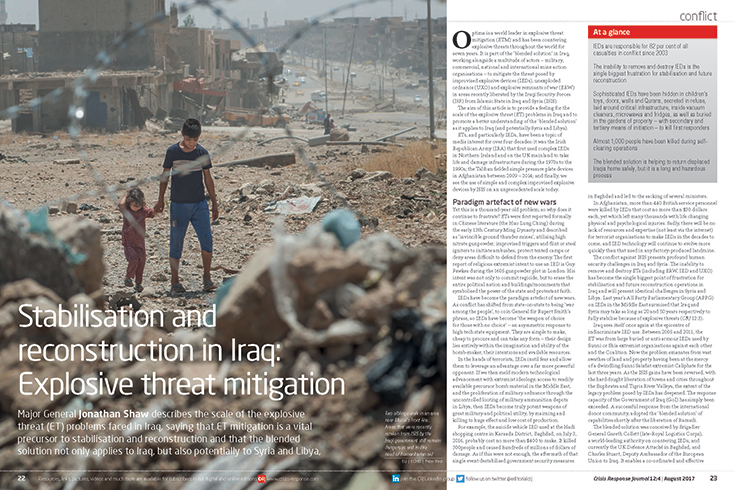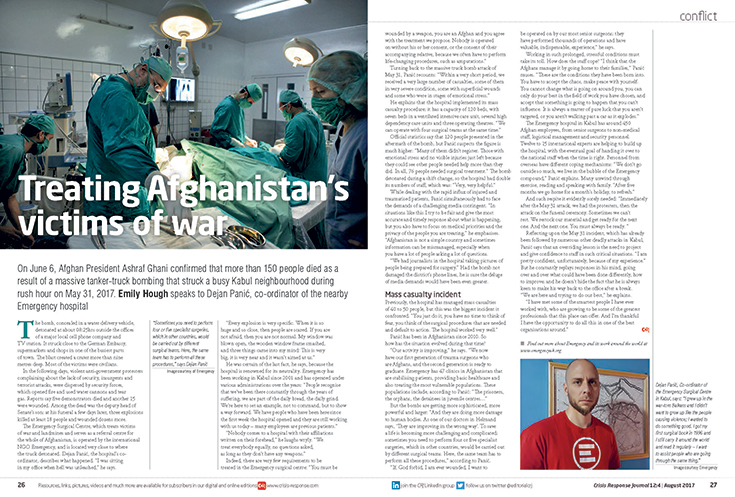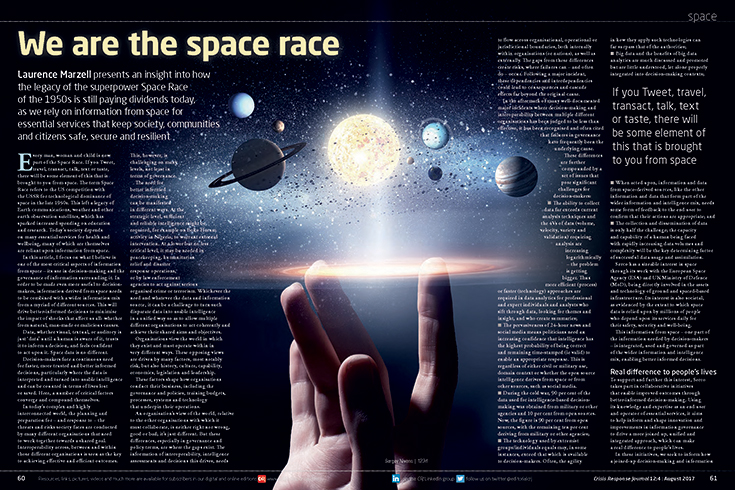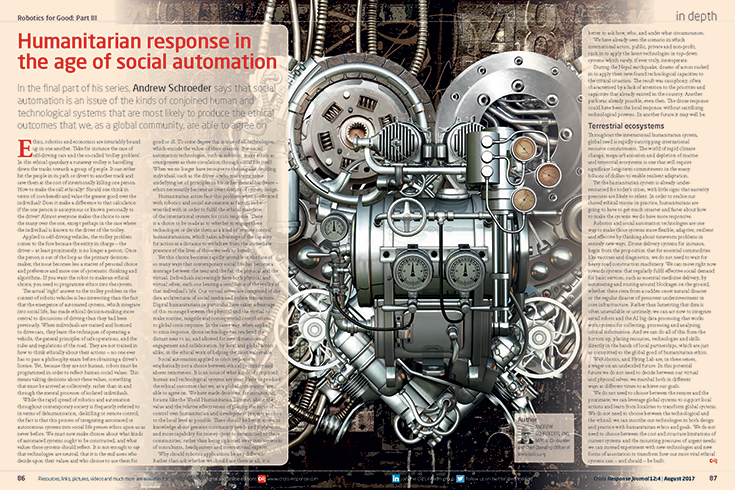CRJ 12:4 published in September
Fake news, terrorist attack analysis, cybersecurity & ransomware, emergency & organisational management, Artificial Intelligence, Earth Observation & space technology for humanitarian applications, search & rescue in the US, NIMs and much, much more, coming up in the next issue of the CRJ
Comment: The fickle finger of fake
Rob Shimmin examines the phenomenon of fake news and its role in crisis creation and management – how do we quieten the echo chamber?
Vehicles as terrorist weapons
David Stewart was Silver Command during the Glasgow Airport terrorist attack ten years ago. Here, he describes the incident and outlines how security measures have since deterred attacks using vehicles at airports
Terrorist attacks in the UK
Roger Gomm, CRJ’s Security Correspondent, takes a look at events in Manchester and London
Radicalisation in Central Asia
A Europol Report found that North Caucasians make up a powerful contingent of foreign terrorist fighters in the Middle East. But radicalised operatives from the ex-Soviet Union regions of Central Asia and the Russian Caucasus are increasingly carrying out attacks elsewhere, says Lina Kolesnikova, who examines some possible underlying reasons for this trend
Talk to me – Lessons from the Lindt café siege
Editorial Advisory Panel Member Andrew Brown, who served as an expert witness into the Lindt café siege inquiry in Australia, provides an insight into some of the findings of the final report on the incident, which resulted in several fatalities
Stabilisation and reconstruction in Iraq: Explosive threat mitigation
Major General Jonathan Shaw describes the scale of the explosive threat (ET) problems faced in Iraq, saying that ET mitigation is a vital precursor to stabilisation and reconstruction and that the blended solution not only applies to Iraq but also potentially to Syria and Libya

Treating Afghanistan’s victims of war
On June 6, Afghan President Ashraf Ghani confirmed that more than 150 people died as a result of a massive tanker-truck bombing that struck a busy Kabul neighbourhood during rush hour on May 31, 2017. Emily Hough speaks to Dejan Panic, co-ordinator of the nearby Emergency Surgical Centre, which treats victims of war and landmines, and serves as a referral centre for the whole of Afghanistan

The Grenfell Tower tragedy: A brief review
The Grenfell Tower fire has been described as an event unparalleled in modern London’s history in the scope and scale of its impact, says David Rubens. And it is an indication the fragility of the crisis management frameworks that we rely on so heavily
Ransomware: The trap within the trap
The big distinction between ransomware and malware is that you know when the ransomware criminal comes calling. You either pay up or you lose your data. Very few of us know when an attacker owns our computer with malware, and that's the real problem, writes Todd Rosenblum
Getting to grips with cyber security
The common and somewhat fatalistic rhetoric is that it’s not a case of if a business will suffer a cyber attack, but when. If we believe this, we are all doomed. But there are fairly straightforward things your business can do to help avoid being a victim, says Gary Fairley
What does resilience mean in the UK?
Sarah Ponesch interviewed five UK stakeholders on the concept of resilience, with the aim of identifying the UK-specificity of resilience as a ‘culture’ in an ever-changing world. Here, we present an abridged version of her paper, produced for the Austrian Institute for International Affairs
Organisational resilience
Anticipation, assessment, prevention, preparation, response and recovery – these are the vital areas that any organisation should be looking at when considering its resilience, says Roger Gomm
Community in a crisis: An alternative paradigm
People’s behaviour in crisis is a key consideration, and their role is frequently referred to as that of ‘victim’. Dennis Davis suggests that resilience becomes more focused upon the citizen, with matters of vulnerability and consequence being considered at the planning stage
Workplace violence crises
Richard Diston examines the phenomenon of workplace violence, saying that it can often be an organisational crisis, whether in a private or public sector organisation. But how to eliminate violent conduct and ensure a safe workplace for all employees? The starting point is leadership
Emergency management on remote islands
How do you undertake disaster management on one of the world’s most remote islands? Ian Johnson describes the particular challenges of protecting the island of St Helena in the South Atlantic
Ground search and rescue in the USA
Martin Boyle speaks to Chris Boyer, Chief Operations Officer for the United States based National Association for Search and Rescue (Nasar) about the challenges of working across multiple states with different legislation and certification standards
Leveraging Artificial Intelligence for good
AI has enormous potential for social good, says Houlin Zhao, Secretary General of the International Telecommunication Union (ITU), but we need paths forward for safe, trusted, ethical solutions to make the world a better place. This is why the ITU – together with XPrize – held the AI for Good Global Summit in June this year
Shaping the future of Artificial Intelligence
The near infinite possibilities of AI seem only to be bounded by human imagination, but how we instil ethical principles during its early stages of infancy could have positive or negative repercussions for decades, if not centuries. Emily Hough talks to Sherif Elsayed-Ali of Amnesty International to find out more
We are the Space Race
Laurence Marzell presents an insight into how the legacy of the superpower Space Race of the 1950s is still paying dividends today, as we rely on information from space for essential services that keep society, communities and citizens safe, secure and resilient

A view from above: Earth observation
Dalia Kirschbaum and her colleagues outline how NASA, working with partners around the world, is helping to harness the incredible scope and range of Earth observations for disaster response and risk reduction teams on the ground
Space technology and the Sendai Framework
Space-based technology and Earth Observation can be of immense value in disaster management and risk reduction strategies, say Joachim Post, Juan-Carlos Villagran and Luc St Pierre. But more effort is needed to make this data usable by developing countries
Governance and ICT solutions for reducing flood risk
Technology is developing at an astonishing rate, but disaster governance and response systems are not always keeping pace. Davide Miozzo and Davide Poletto describe some projects that aim to embed ICT and space technology in the daily work of first responders
The threat of orbital debris
We know much humanity has come to rely on space technology, and the immense benefits it presents in the disaster sphere. But this could stall if the issue of space junk is not addressed. Emily Hough speaks to Nobu Okada of Astroscale, a company that aims to secure long-term spaceflight safety, which is one of the World Economic Forum’s 2017 class of Technology Pioneers, representing the world’s most innovative start-ups and scale-ups
The remarkable potential of 3D printing in healthcare
3D printing has become a highly versatile and progressively cost-effective technology, permeating a variety of fields, including healthcare, say our R&D writers, led by Ian Portelli
Computer modelling in large-scale incidents
In this look at computer modelling in crisis response training, Friedrich Steinhäusler examines how 3D modelling of people, vehicles, weapons, explosions and the release of toxic materials can help first responders – both in training and during actual events
DJI and EENA release white paper on drones
Petros Kremonas brings news of a pilot project between drone manufacturer DJI and the European Emergency Number Association, saying that perhaps, in a few years, having drone available within an emergency rescue organisation will be as routine as having a telephone line
The Progress of NIMS: Part I – What is the impact of the NIMS mandate?
Nicholas B Hambridge, Arnold M Howitt, and David W Giles begin this series that looks at how successful the diffusion of the National Incident Command System has been across the US by presenting some of the factors that affect its implementation
Robotics for Good: Part III – Humanitarian response in the age of social automation
In the final part of his series, Andrew Schroeder says that social automation is an issue of what kinds of conjoined human and technological systems are most likely to produce the ethical outcomes that we, as a global community, are able to agree on

Firefighting in tunnels: Part IV – Operational limits with respiratory protection
Christian Brauner discusses the limits of respiratory protection in underground transport systems, reminding us that the fire services’ penetration depths are the same tunnel users’ escape routes
Early warning, small islands: Part II – Risk analysis and knowledge
In the second part of this series looking at early warning systems in small Caribbean Islands, Marlon Clarke and Danielle Evanson examine how vulnerability and capacity assessments are such a vital part of the process to enhance understanding of risks and reducing vulnerability
Looking back: Fires in high-rise buildings
In the light of the catastrophic fire at Grenfell Tower in West London, Tony Moore looks back at recent high-rise building fires in Britain
Frontline
CRJ speaks to Tony Tesar of LeBeck International